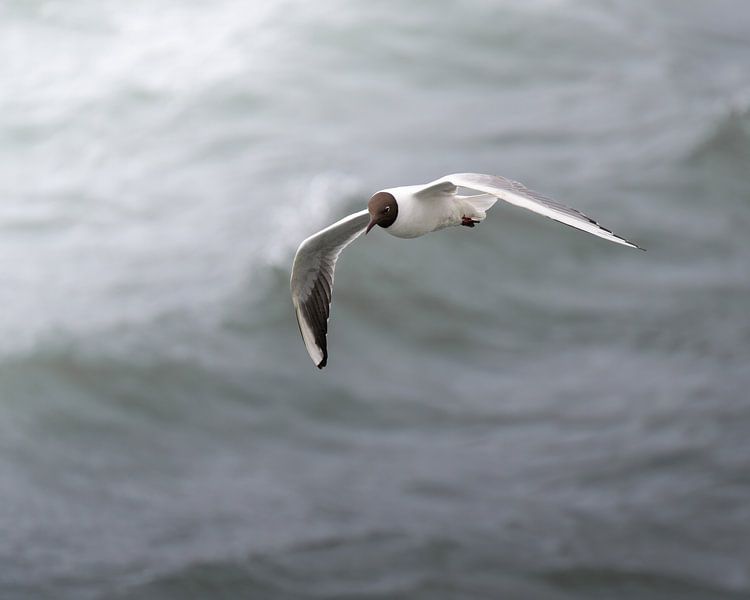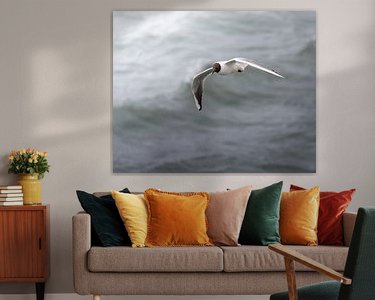Buy this bird art A black-headed gull in flight by Anges van der Logt on canvas, ArtFrame, poster and wallpaper, printed on demand in high quality.
About "A black-headed gull in flight"
by Anges van der Logt
About the artwork
The black-headed gull (also: hooded gull) (Chroicocephalus ridibundus) is a very common gull species. The species used to be classified in the genus Larus, but research on mitochondrial DNA has shown this to be incorrect. Black-headed gulls are very similar to the lesser black-backed gull (only a rare breeding bird in the Netherlands), the black-headed gull (an even rarer breeding bird), the fork-tailed gull (an irregular guest) and the giant black-headed gull (a bird that has only been spotted once in the Netherlands). They are also very similar to the thin-billed gull, which also has a light forewing. The black-headed gull has a life expectancy of 10-15 years, but can also live to be more than 30 years old. In Europe, and especially inland, they are the most common gull species and thus the most familiar. Black-headed gulls are breeding birds on nutrient-rich inland waters from Iceland to Kamchatka. The bird spreads in winter to the Mediterranean, Red Sea, Persian Gulf, coasts of India, China and Japan. They breed both near the sea and on freshwater islets.

About Anges van der Logt
A dutch photographer living in Jakarta, Indonesia since 1995. Specialized in landscapes and culture, mainly of Indonesia but also from other countries in Asia and elsewhere.
For examples you can have a look at my Instagram accounts: @angesvdl and @angesvdl.world..
Read more…
 Netherlands
Netherlands Ordered in June 2021
Ordered in June 2021
 Germany
Germany Ordered in August 2019
Ordered in August 2019
 Netherlands
Netherlands Ordered in July 2019
Ordered in July 2019
 Germany
Germany Ordered in February 2024
Ordered in February 2024
 Germany
Germany Ordered in August 2025
Ordered in August 2025
 Netherlands
Netherlands Ordered in April 2021
Ordered in April 2021
 Germany
Germany Ordered in April 2025
Ordered in April 2025
 Germany
Germany Ordered in May 2022
Ordered in May 2022
 Netherlands
Netherlands Ordered in February 2025
Ordered in February 2025
 Germany
Germany Ordered in August 2025
Ordered in August 2025
 Netherlands
Netherlands Ordered in June 2021
Ordered in June 2021
 Netherlands
Netherlands Ordered in July 2023
Ordered in July 2023
About the material
ArtFrame™
Interchangeable Art Prints
- High-quality print
- Easily interchangeable
- Acoustic function
- Large sizes available
Discover the artworks of Anges van der Logt
 The gamelan maestro Ki Suripto on his gamelan in Salatiga, Central Java, IndonesiaAnges van der Logt
The gamelan maestro Ki Suripto on his gamelan in Salatiga, Central Java, IndonesiaAnges van der Logt Old balinese woman with her spinning wheel in a small village near Ubud, Bali.Anges van der Logt
Old balinese woman with her spinning wheel in a small village near Ubud, Bali.Anges van der Logt Kilchurn Castle on a quiet early morning in summerAnges van der Logt
Kilchurn Castle on a quiet early morning in summerAnges van der Logt An old tree above the lake of the volcano Ijen in East JavaAnges van der Logt
An old tree above the lake of the volcano Ijen in East JavaAnges van der Logt The Torii gates of Tara that lead you into the oceanAnges van der Logt
The Torii gates of Tara that lead you into the oceanAnges van der Logt Torii gate at Lake Biwa in JapanAnges van der Logt
Torii gate at Lake Biwa in JapanAnges van der Logt Javanese boy with his carrier pigeonsAnges van der Logt
Javanese boy with his carrier pigeonsAnges van der Logt Help in the kitchenAnges van der Logt
Help in the kitchenAnges van der Logt Sorting rice in the traditional wayAnges van der Logt
Sorting rice in the traditional wayAnges van der Logt I'm waiting for youAnges van der Logt
I'm waiting for youAnges van der Logt The potterAnges van der Logt
The potterAnges van der Logt Reading a book in the window frameAnges van der Logt
Reading a book in the window frameAnges van der Logt Bike in the fogAnges van der Logt
Bike in the fogAnges van der Logt Fishing in the early morningAnges van der Logt
Fishing in the early morningAnges van der Logt A flock of Oystercatchers on the beach near Paesens/ModdergatAnges van der Logt
A flock of Oystercatchers on the beach near Paesens/ModdergatAnges van der Logt Borobudur in the morning mist (vertical)Anges van der Logt
Borobudur in the morning mist (vertical)Anges van der Logt Borobudur temple during sunriseAnges van der Logt
Borobudur temple during sunriseAnges van der Logt The footbridge in the forests of YakushimaAnges van der Logt
The footbridge in the forests of YakushimaAnges van der Logt Two Javanese men in an arm fightAnges van der Logt
Two Javanese men in an arm fightAnges van der Logt The arm fight in Central JavaAnges van der Logt
The arm fight in Central JavaAnges van der Logt













 Animals
Animals Atlantic Ocean
Atlantic Ocean Birds
Birds Iceland
Iceland Photo wallpaper
Photo wallpaper Photography
Photography Seagull
Seagull Serene Peace
Serene Peace









